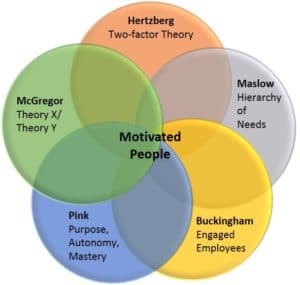Psychologists, including Maslow, Hertzberg and McGregor studied what motivates people during the nineteen-sixties. Their work still constitutes a sound foundation for today’s leaders to understand the basics of what makes people tick. Since then many thinkers have contributed to a rich body of knowledge that provides the basis to shape a more effective way of leading and managing. Pink and Buckingham show us effective ways to motivate, lead and manage people in the modern era.
 Figure 1: Motivational theories - the old and the new
Figure 1: Motivational theories - the old and the new
The theories of the masters still hold true today
Maslow’s Hierarchy of Needs identifies five fundamental needs: physical, security, belonging, esteem and self-actualisation. While the needs are presented as a hierarchy, it is not necessary to fully satisfy a lower level need to be motivated to satisfy a higher need; but more basic needs will tend to dominate when materially unsatisfied or under threat.
Hertzberg’s Two-factor or Motivation-Hygiene Theory proposes that there are factors that motivate or drive satisfaction and a different set of factors that can demotivate leading to dissatisfaction, the so called hygiene factors. Factors such as status, salary and working conditions are hygiene factors; associated negativity will cause demotivation but positivity will not drive up motivation. He proposed that motivation arises from more intrinsic factors such as appreciation, personal growth and meaningful work.
McGregor’s Theory X and Theory Y presented two opposing models for managing and motivating based on underlying assumptions held about how people will behave. In Theory X managers believe people are fundamentally lazy, unambitious and needing to be driven to achieve results. Theory Y is the opposite, in which managers assume people will be intrinsically motivated to achieve results. Interestingly the Pygmalion effect has been seen to apply i.e. the manager’s treatment as-if people are X or Y will cause them to eventually become the way they are treated.
The new kids on the block bring it together
Buckingham did extensive research while at Gallup to understand what makes successful managers and leaders. He concluded that focusing on developing peoples’ strengths and helping them to use them consistently led to “engaged employees”, rather than placing emphasis on trying to develop so called weaknesses. His work confirmed the effectiveness of the theories presented by Maslow, Hertzberg and McGregor.
Pink conducted his own experiments to determine the effectiveness of rewards as a means to motivate and improve performance, firstly when doing routine work and then when work involved more creativity, lateral thinking and problem solving. He discovered that performance in the latter scenario deteriorated when rewards for specific performance levels was introduced. He proposes that in that case motivation is improved through having a meaningful purposes, giving people autonomy and establishing a culture that fosters development of mastery; again consistent with the earlier theories.
Resources
- Maslow's Hierarchy of Needs
- Are you a Theory X or a Theory Y Leader
- Using Hertzberg's Motivation Theory
- First, Break All The Rules
- The Motivation Trifecta: Autonomy, Mastery, and Purpose
This is the first of two posts by David Preece. David is a Lean-Agile Maven at Standard Bank South Africa.
If you like this post and want to learn more, subscribe to our blog via email (top right hand corner). You will also be the first to be notified of the follow-up post on Motivation.




One thought on “Why motivation of people needn’t be confusing”